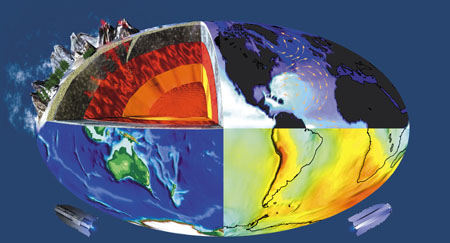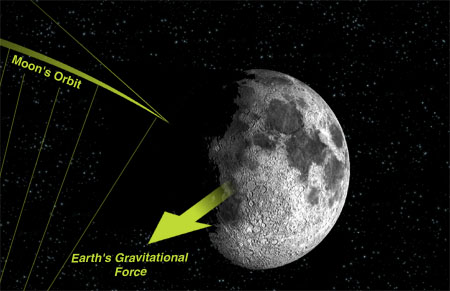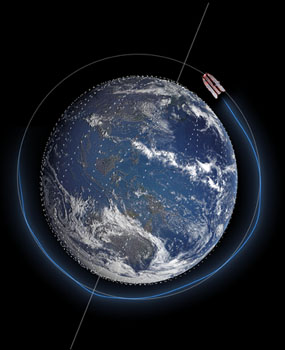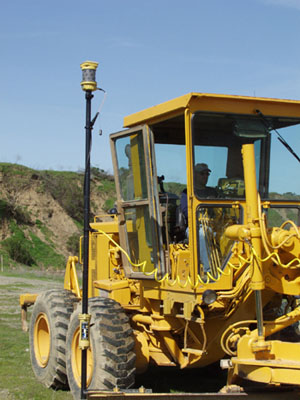Geodesy
What is Geodesy?
The Earth is not a mass of solid rock, but due to the increase of temperature towards the center it is built up from a mixture of viscous and solid materials. Thus the shape of the Earth is oblate, because the centrifugal force stemming from its rotational motion pulls the masses out along the equator.
What about the hills, mountain ranges, deep sea trenches?
These ‘topographic features’ are really small compared to the size of our planet. Of course they are measured and drawn on maps, but in Geodesy their contribution to the shape of the globe is quite small.
These topographic features range from 9 km above the sea level (Mount Everest) and 12 km below the sea level (Mariana trench). Comparing these values to the diameter of the Earth of roughly 12756 km, the topographic variations are really small.
However as the accuracy of our observation techniques improves, the topographic features become more and more important. The gravitational effects of the masses stored in topographic features are no longer negligible for geodetic investigations.
Quite simply: Geodesy is the science of studying the shape, size and gravity field of the Earth
The Earth seems to be round, or not?
In reality the Earth is not perfectly round. Knowing the exact shape of the Earth helps us providing accurate maps of the Earth.
What is Geodesy?
Why do we need accurate maps?
Remember the old saying:
“You can not tell where you are going unless you know where you have been.”
Maps usually play an important role in our life. We need them to find our way in the world. In ancient times mankind used landmarks to find their way to friends, or other places. Such an itinerary could sound like this: “Travel toward the highest mountain peak, until you come to a big rock, then find the largest tree in the vicinity. I live under that tree”.
Today we often use urban landmarks, such as shopping malls, churches, skyscrapers, etc. But what happens, if we are not familiar with the town?
Therefore we need accurate maps, which cover a large area and show more details (landmarks, etc.).
In order to create accurate maps, we need a - so called - spatial reference system. A spatial reference system defines a coordinate system, in which all landmarks have a unique address (the co-ordinates).
To create such a spatial reference system, one should know the accurate shape of our planet.
Is the Earth really round?
During the evolution of the geodetic science, the research showed that the shape of the Earth is not round, but it ‘bulges’ outward all along the equator.
What is Gravitation? - From the Apple ...
Knowing more about the gravitational field of the Earth can improve our lives, and help us to grow and to benefit both economically and socially. It helps us understand climate change, sea level rise, and geologic hazards (earthquakes, volcanoes); and it makes possible practically all satellite applications, as well as precise navigation systems.
Since our planet is made of different materials, its gravitational field shows local variations (called anomalies). Observing these anomalies can help us to explore the subsurface mass distribution of our planet. In this way we may look into the interior of the Earth.
What affects the gravitational field?
- mass density variatons inside the Earth;
- the oceans - the level of oceans changes due to temperature, ocean currents, etc. Changes in the level of oceans change the gravitational field, too.
- the Sun, Moon and other planets - the gravitational effects of the planets vary according to their position relative to the Earth.
- ice sheets - they compress the Earth's crust beneath them. Changes in the ice caps (e.g. melting due to the greenhouse effect) may reduce this compression, thus the gravitational field changes.

These effects are only examples. However we can see how complicated our planet is, and how these components interact with each other. In the first Section we defined Geodesy as a science of studying the shape, size and gravitational field of the Earth. But what is the gravity field, and why is it important?
What is Gravitation? - From the Apple ...
Gravitation in a nutshell
Gravitation is a force that pulls or attracts all bodies in the universe towards each other because they have mass. Planets remain in their orbits around the Sun due to this force. The gravitational force depends on the amount of mass of the bodies. In Geodesy, we usually distinguish “gravity” as gravitation plus centrifugal acceleration due to Earth's rotation because traditionally we can measure gravity, not gravitation, at points on the rotating Earth.
Newton's Apple
Sir Isaac Newton proposed that Earth's gravitation causes such things as the fabled apple to fall and is the same force that keeps planets in their orbits. For example, he figured out that the Moon would travel in a straight line without the attraction from the Earth pulling it into a curved path (the orbit).

What is Gravitation - ... To the Satellites
Why do we need to study the gravitational field?
Gravitation affects almost everything in our lives. From precise clocks to hydroelectric dams, from the tides of the oceans to blood circulation.
We study the Earth's gravitational field to learn more about our planet. This knowledge can lead us to new ways of doing everyday things with greater awareness towards sustainability of our environment for future generations.
How can the satellites help?
If we want to study the gravitational field globally, terrestrial gravity measurements have some huge limitations, mostly because they do not cover the whole globe homogeneously. Moreover, in some places of the world, these observations are highly confidential because gravity measurements lead exploration geophysicists to oil fields and allow military planners to guide missles.

Satellite missions such as CHAMP, GRACE and GOCE help us to study the global gravitational field of the Earth. These Low-Earth Orbiters (LEOs) provide us a global, homogeneous coverage of gravitational observations.
Why is Geodesy fundamental to the Society?
Geodesy has a long tradition of assessing the requirements from various parts of the society and of projecting these into future developments of the geodetic techniques and observing systems.
Today, geodesy is the science of determining the geometry, gravity field, and rotation of the Earth and their evolution in time. This understanding of modern geodesy has led to the definition of the three pillars of geodesy, namely (1) Geokinematics, (2) Earth Rotation and (3) the Gravity Field. These three pillars are intrinsically linked to each other, and they jointly change as a consequence of dynamical processes in the Earth system as a whole. The changes in Earth's shape (including the surface of the water and ice bodies), i.e. the geokinematics, are the result of dynamic processes in the solid Earth and its fluid envelope, affecting mass distribution and angular momemtum, and thus changing the gravity field and Earth rotation.
Traditionally, geodesy has been a service science, providing an important utility to other sciences and many applications. This aspect has remained unchanged, and a principal tool and output of geodesy is a reference frame allowing the determination of the position of points relative to each other. But geodesy has developed into a science that can no longer satisfy this service aspect without encompassing and monitoring the whole Earth system, its kinematic and dynamics. As an additional benefit, geodesy is increasingly forced not only to „measure” the geokinematics, gravity field, and rotation, but also to „model” these quantities on the basis of mass transport and dynamics.
A deeper understanding of the Earth system cannot be achieved without sufficient observations of a large set of quantities characteristic of Earth system processes. Earth observations are not only necessary for a scientific understanding of the Earth, they are fundamental for most societal areas ranging from disaster prevention and mitigation, the provision of resources such as energy, water and food, aiming an understanding of climate change, the protection of the biosphere, the environment, and human health, to the building and management of a prosperous global society.
Geodesy is fundamental in meeting this global challenge because geodesy provides the foundation on which all Earth observation systems are built. In this function, geodesy is essential for Earth observation just like the foundation and frame of a house are necessary to keep it stable over time. But modern geodesy does more: with its „three pillars” of geokinematics, Earth gravity field, and Earth rotation, it also provides comprehensive observations of changes in the Earth's shape, gravity field and rotation. These fundamental geodetic quantities are intimately related to mass transport in the fluid envelope of the solid Earth and its interior, as well as the dynamics of the Earth System. Therefore, the geodetic observing system contributes essentially to the Earth observation database. It turns out, not surprisingly, that the geodetic observing system is similarly essential for exploring the planets, the solar system, and beyond.
Geodesy and the Society
Geodesy is in a transition due to the fact that the advent of space-geodetic techniques and the rapid improvement of communication techniques and capacities have fundamentally changed, if not revolutionized, geodesy and its methods. While previously point coordinates were given with respect to local or regional reference frames, with space geodetic techniques positions can now be observed with respect to a global reference frame with unprecedented accuracy. Based on these techniques, changes in Earth's shape, rotation and gravity field are provided with increasing spatial and temporal resolution, increasing accuracy, and with decreasing latency.
The societal prospects of space geodesy are fundamental. The technological development facilitated through the new space-geodetic techniques for navigation and positioning poses new and difficult challenges and continuously creates new requirements in terms of accessibility, accuracy and long-term stability. The rapid development of satellite-based precise point positioning techniques, which allows the determination of very accurate position anytime and anywhere on the planet, enables a wide range of position-related applications. The new geodetic technologies are leading to fundamental changes not only in all areas of navigation and transport, but also for application in process control (e.g. farming, construction, mining, resource management), construction and monitoring of infrastructure (e.g. off-shore platforms, reservoirs dams, bridges, and other large civil structures), surveying and mapping (including off-shore), and Earth observation. Geodetic techniques are crucial in the assessment of geohazards and anthropogenic hazards, and they will play a pivotal role in early warning systems of such hazards and disasters.

The prospect of these changes is increased security, a better use of resources, and progress towards sustainable development.
The availability of a global geodetic reference frame such as the International Terrestrial Reference Frame (ITRF) and the tools to determine precise point coordinates anytime and anywhere on Earth have a profound effect on almost all areas of society. Moreover, since the ITRF is available anywhere on the planet, it improves access to an important technological resource. Therefore, it is an important contribution compatible with the principle of sustainable development demanding equal access to resources for all.
Geodesy is crucial not only for Earth observation and science, but today it is also indispensable for the maintenance of many activities in a modern society. Traditionally, geodesy has served society by providing reference frames for a wide range of practical applications from regional to global navigation on land, sea and in air, construction of infrastructure, to the determination of reliable boundaries of real estate properties. Reference frames were, however, national or regional in scope, and they were suited for the determination of coordinates relative to a network of reference points. Thus, determination of precise point coordinates required simultaneous measurements at several points.
Satellite missions such as CHAMP, GRACE and GOCE help us to study the global gravitational field of the Earth. These Low-Earth Orbiters (LEOs) provide us a global, homogeneous coverage of gravitational observations.
Geodesy and the Society
Today, the Global Navigation Satellite Systems (GNSS) provide access to precise point coordinates in a global reference frame anytime and anywhere on the Earth's surface with centimeter-level accuracy and without requiring additional measurements on nearby reference points.
On the user side, this technological development has stimulated new applications demanding even greater accuracy and better access to geodetically determined positions. On local to regional scales, applications such as land surveying, monitoring of infrasructure, prevention and mitigation of impacts of environmental hazards, and numerous technical applications require more or less instantaneous access to geodetic positions in a reliable reference frame with centimeter-level accuracy or better. Already today, the economic benefit of the geodetic reference frame is enormous.
Geodesy provides the foundation for all Earth observations as well as crucial observations of changes in the Earth's geometry, gravity field, and rotation, which are all related to mass transport in the Earth sytem and the system dynamics. Therefore, geodesy is crucial for meeting many of the requirements for observations of global change and observations supporting studies of the Earth system. Providing the basis for precise positioning, geodesy is also crucially supporting many processes in a modern society.
Currently, geodesy is facing an increasing demand from science, the Earth observation community, and society at large for improved services, observations and products. Most of these requirements are in terms of improved accuracy, better reliability (including addressing the issue of liability), and improved access to the reference frame.
Historically, geodesy was limited to determining the shape of the Earth, its gravity field, and its rotation including their changes over time. With modern instrumentation and techniques, the scope of geodesy has extended to include the sources of the observed changes in these „three pillars”, i.e. the dynamics of and mass transport within the Earth system. With this broader scope new pathways emerge in which geodesy can contribute to the scientific understanding of the Earth system as well as the development, functioning, and security of society in general.
To a large extent, geodesy is a „service science”. In the past, the main „customers” of geodesy came from the surveying and mapping profession, while today geodesy serves all Earth science, including the geophysical, oceanographic, atmospheric, and environmental science communities.
Geodesy provides a unique framework for monitoring and ultimately understanding the Earth system as a whole. Modern space-geodetic techniques are well suited for observing phenomena on global to regional scales, and thus are an important complement to traditional in situ observation systems.
Geodetic observations and products are crucial for the utilization of the benefit of Earth observation since geodesy provides the foundations for a global geodetic reference frame (such as the ITRF) that can be used by all Earth observing systems to monitor atmosphere, ocean, and other resources, and that allows measurements in a globally consistent reference frame. Monitoring quantities relevant for geohazards, the global water cycle, climate and weather, energy, and even health, depends crucially on ready and reliable access to a reference frame.